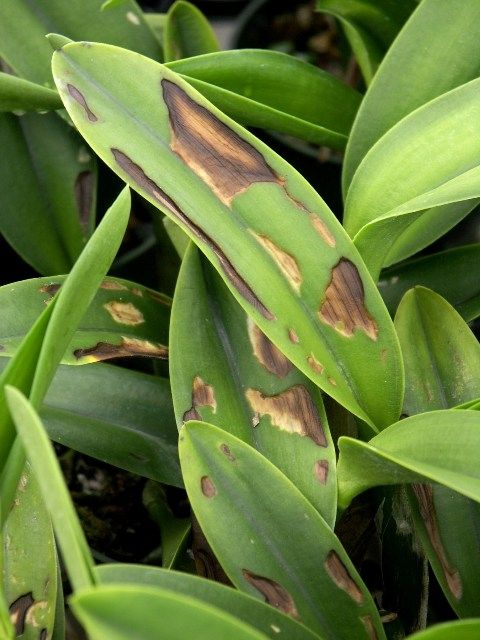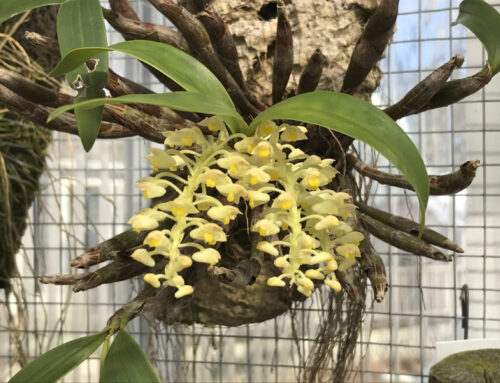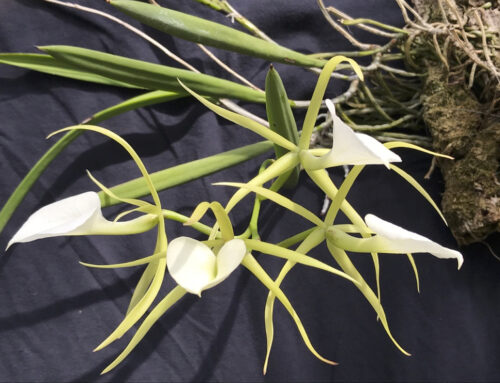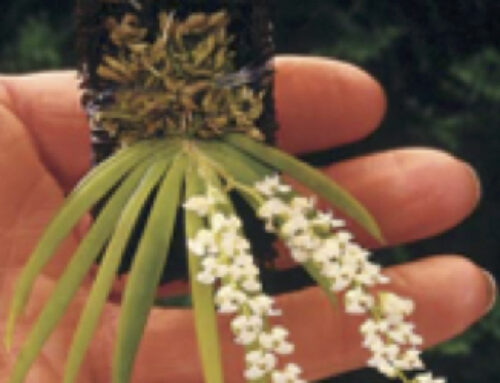By Ron McHatton with Photographs by Greg Allikas
Summer presents challenges in the form of increased pest activity, fungal and bacterial problems in traditionally wet areas and desiccation in those areas with Mediterranean-like climates where summers are typically quite dry. Careful observation of your plants is the best way to identify small problems before they become big problems, and in the summer, the time between these two events is dramatically shorter due to higher temperatures.
Pest Control
For small collections, the best thing to do is to physically wipe insects of and clean the plant. Isopropyl alcohol and a cotton swab are effective against most pests and if you want to increase its effectiveness, a drop of Ivory dishwashing liquid added to the alcohol helps wet the typically waxy surface of orchid leaves. If you haven’t been watching carefully and the infestation gets out of control, you might have to use chemicals. Few pesticides are specifically rated for use on orchids, but you can use any that are labeled for ornamentals. Use care and follow the label directions. This is not a situation where if a little is good, more will be better.
In areas with dry summers, mites can be a serious problem, especially on phalaenopsis. These creatures attack the surface of the leaves producing a sort of rough silvery appearance. Mites are not insects and insecticides offer little or no control. Mites do not like humid conditions so efforts to increase humidity are beneficial. Light infestations can be controlled by thoroughly cleaning plants but in hot, dry climates light infestations rapidly become serious and control is best accomplished by the use of a miticide.
In areas with wet summers, wet foliage and high humidity encourage the spread of fungal and bacterial diseases. Bacterial diseases do not respond to fungicides and vice versa so it’s important to know which disease you are dealing with. Perhaps the easiest way to distinguish between the two is by smell. The most common bacterial disease in orchids produces a foul smell often likened to dead fish. If you’ve ever had cut flowers stand too long in water, you know the sort of smell we’re talking about.
Diseases can spread quickly. Bacterial diseases kill plants especially rapidly and time is of the essence. Both bacterial and fungal diseases are spread by splashing water, and this includes rainfall. Use a clean cutting tool such as a single-edge razor blade, cut off the infected tissue as well as at least an inch (2.5 cm) of clean, green area and then treat the cut surface with a fungicide. Even if the problem is bacterial, you don’t want a fungal infection to start in the wound. Cinnamon — the common spice — is effective against fungal diseases and can be used to coat the cut surface. It’s perhaps not as effective as a chemical fungicide but it’s readily available and does work.
Where it’s wet, keep your plants as dry as possible. Alternatively, provide a lot of air movement. When you water, try to do so as early in the day as possible. This will allow adequate time for the foliage to dry before nightfall.
In dry-summer areas, the bane of orchid growers is extremely low humidity, and this leads to two issues. The first of these is an increase in the rate at which plants dry out and the other is the ever-presence of mites.
Orchids in dry-summer areas dry out much more rapidly than they did in the winter. Depending on temperature, plants watered every two weeks in the winter may need to be watered every few days in the summer. Here again, nothing will take the place of careful observation. If you have an extensive collection of plants, you might want to consider installing a misting system similar to those used in open-air restaurants in dry areas. Low-pressure units that install on hose lines are inexpensive and work reasonably well to raise humidity as well as cool the growing area somewhat.
Scale, particularly Boisduval scale illustrated on this cattleya plant, is a serious pest on orchids. Dried pseudobulb sheaths should be removed at repotting to inspect for these insects.
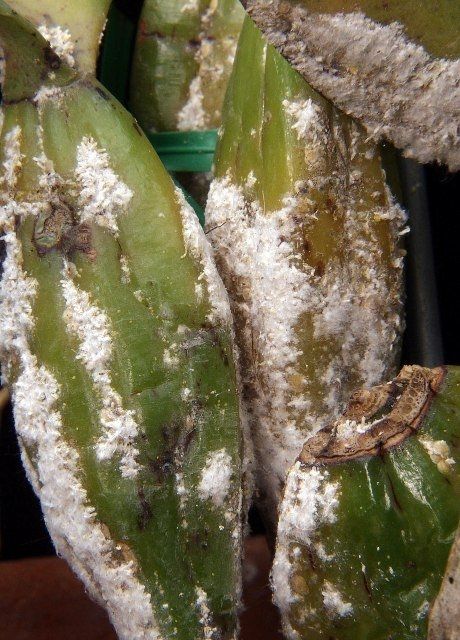
Summer Sun
How does sun affect orchids? Solar radiation is much more intense in the summer and plants that have been thriving in full sun all winter may need a little extra protection (shade) when the sun is at its strongest or, often during the late afternoon, when the temperatures are highest. Orchids are easily sunburned and you should take care when moving plants around, especially if you are moving plants grown inside during the winter to a spot outside for the summer. Sunburn, while not in itself a serious problem is irreversible and will make your plants look ugly. In serious cases the plant can be killed outright and any leaf damage is an invitation to a secondary infection in the damaged area.

Orchid foliage should be a light yellow-green. The first sign of too much light is often yellow foliage. If left alone, this yellow foliage will eventually turn white and then dark brown and dry as the sunburned area dries out. If the problem is caught before the chlorophyll has been completely destroyed it is often possible to reverse the damage. Once white spots or sunken areas have appeared, the damage is irreversible and the best thing one can do is stop further progression with more shade.
Sudden increases in light levels will burn orchid foliage as illustrated here on this Bifrenaria harrisoniae leaf. While small sunburned spots aren’t really detrimental to the plant, they are unsightly and remain for the life of the leaf.
Capitalizing on the High-Growth Season
Because of increased light and temperatures, your plants will benefit from more fertilizer (increased frequency, not concentration). This is especially true for those varieties that put out new growth during this time. Avoid fertilizers that contain significant amounts of urea (formulations with more than 20 percent nitrogen). Urea nitrogen is much less readily available to orchids in soilless mixes than ammoniacal and nitrate forms.
Plants will also dry out faster. To avoid root damage, water plants before fertilizing; the roots will be wet and less easily damaged by the salts in the fertilizer solution.
If you grow your plants inside during the cooler months, moving them outside for the summer is often beneficial and your plants will respond with renewed vigor. Remember, make the transition slowly. Place them under heavy shade for a few days, then somewhat less shade for a few days and then move them to their summer homes, paying attention to the color of the foliage. You’ll be glad you did.
The damage to these hybrid cattleya leaves is heat stress and not sunburn. At high enough temperatures the leaf tissue is killed, resulting in the collapse illustrated here.
